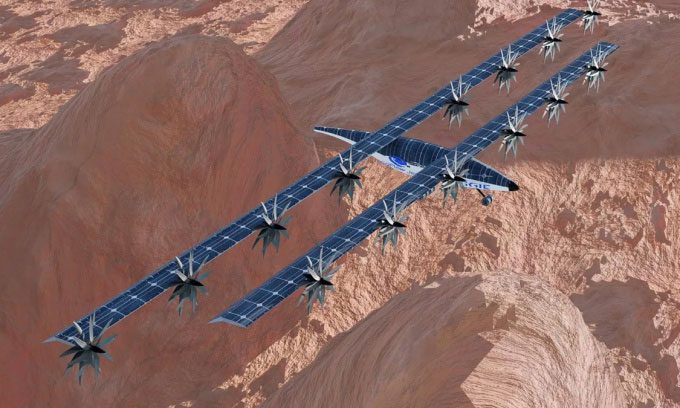The MAGGIE aircraft can fly up to 179 km at an altitude of 1,000 meters, facilitating atmospheric and geophysical research on Mars.
Following the success of the Ingenuity helicopter on Mars, experts are moving towards a more groundbreaking design with a solar-powered fixed-wing aircraft concept, Interesting Engineering reported on January 5th. The aircraft is named the Martian Aerial and Ground Explorer (MAGGIE), announced as part of NASA’s Innovative Advanced Concepts (NIAC) program.

Simulation of the MAGGIE Mars exploration aircraft. (Image: Ge-Cheng Zha).
This compact fixed-wing aircraft boasts extremely high performance, utilizing solar energy to fly within the Martian atmosphere. It has the capability to conduct planet-scale atmospheric measurements, ushering in a new era of space technology. The aircraft concept is proposed by the American aerospace firm Coflow Jet. The unique CoFlow Jet (CFJ) technology will enable the aircraft to navigate the thin atmosphere of the Red Planet.
MAGGIE is expected to fly 179 km at an altitude of 1,000 meters with a fully charged battery over 7.6 Martian days. The aircraft’s operational range is estimated to reach 16,048 km within a Martian year. According to preliminary plans, it will conduct at least three extensive studies on atmospheric and geophysical properties during its mission. The data collected will enhance our understanding of Mars and increase exploration and research capabilities for the future.
The mission of MAGGIE includes a comprehensive exploration strategy aimed at shedding light on the mysteries related to Martian geophysics, atmospheric chemistry, and the potential for past and present life support on the planet. NASA also aims to study the origin and duration of Mars’ magnetic field-generating core, investigate the source of methane signals in Gale Crater, and map subsurface water ice at mid-latitudes.
MAGGIE will advance the rapidly developing Vertical Take-Off and Landing (VTOL) technology. VTOL enables the aircraft to ascend and descend vertically without the need for runways. NASA stated that successfully demonstrating this technology on Mars could pave the way for similar flying missions on other planets in the Solar System. The technology of MAGGIE may also enhance VTOL aircraft development on Earth.


















































